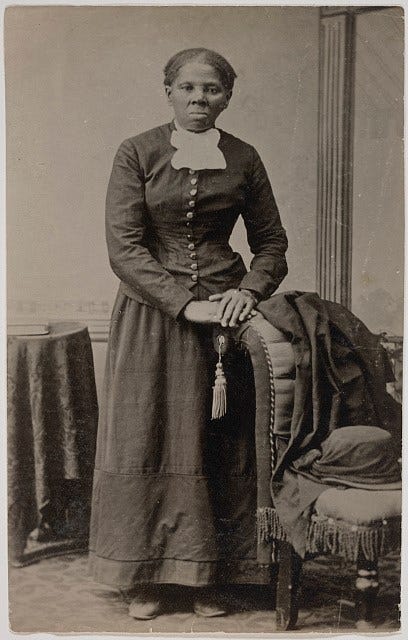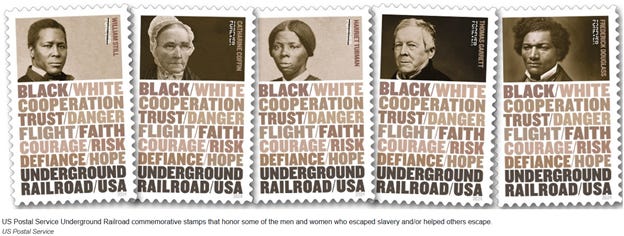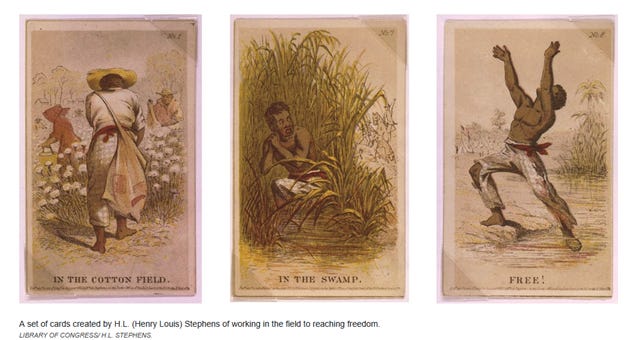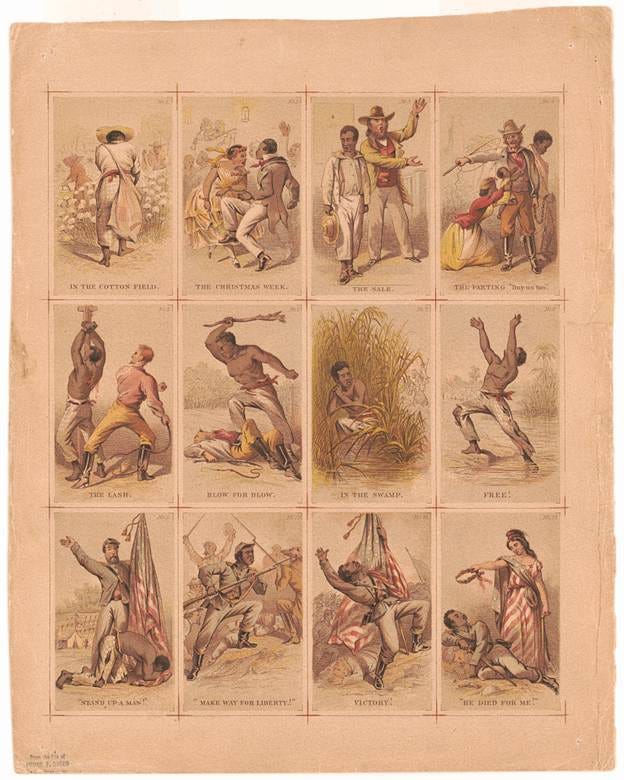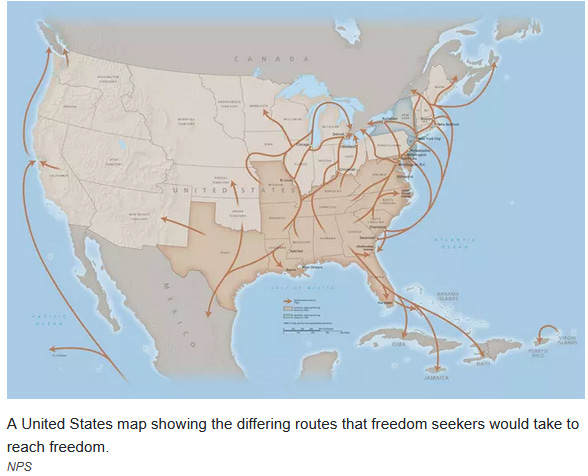National Park Service Brings Harriet Tubman Back to the Underground Railroad!
After public outcry, the National Park Service restores its information page on the Underground Railroad
I was the conductor of the Underground Railroad for eight years, and I can say what most conductors can't say — I never ran my train off the track and I never lost a passenger.
-Harriet Tubman, 1896
April 8, 2025. After public and scholarly outcries, the National Park Service has brought back Harriet Tubman to their information page on the Underground Railroad! View it here: https://www.nps.gov/subjects/undergroundrailroad/what-is-the-underground-railroad.htm
The National Park System is the country’s steward of providing national history as told through historical sites. I am so relieved that they listened—and responded.
Remember that you can give them feedback on their sites. A feedback form is at the bottom of the page. Yesterday, I sent in a complaint about the revised site.
Today, I sent in a thank you.
Your voice matters! The National Park Service is under tremendous pressure from this administration to survive and to keep providing their services to the American public. But they still must be held accountable to the truth of history.
They listened. They knew they had to change it back. And they did!
Thank you for your support of this issue. I will be keeping this post around just as a record, and hey, I hope you can learn about the remarkable imagery on the site—that is still on the site!!!
________________________________________________
Original post from 4/7/25
On the National Park Service’s website about the Underground Railroad, one of the most important female black American figures in American history has been minimized to a head shot image on a postage stamp, alongside images of other historical figures, including Frederick Douglass.
Harriet Tubman, well known for her efforts in leading other enslaved people to freedom in the Civil War period, used to be the headliner on the page, including a quote and her picture (included above). Stringing together a series of head shots from stamps is the National Park Service’s recent attempt to placate the anti-woke directives of the Trump regime to present American history in a scrubbed-down, struggle-free version of American history. See the current version here: https://www.nps.gov/subjects/undergroundrailroad/what-is-the-underground-railroad.htm
Revision and scrubbing of diverse, inclusive, and equitable history from federal sites have become commonplace since the Trump regime took over. It’s still ongoing, and therefore, we cannot become complacent about it, for our history is, to put it very basically, being whitewashed to present a history that does not include the racist struggle for equality that has been at the heart of our American history. Instead, we are now receiving a softer, whitewashed version that shows cooperation and docility between blacks and whites to retell in “gentler” terms the narrative of the horrific emancipation of human beings from the practice of slavery upon which this country was built.
The National Park Service has been telling the stories of American history when it was expanded by President Franklin D. Roosevelt to include historical sites. As such, they are the gatekeepers of our nation’s history. It is a sacred duty, and one, as we know, that has been attacked by the Trump administration, first in the severe personnel cuts made to the rangers who staff the sites. The ones remaining will have to follow the softer telling of history, and the online presence of the parks is being revised. The National Park Service is making these changes under federal orders to create a lighter version of that history to make it more acceptable to the MAGAs.
This recent scrubbing/revision of the Underground Railroad website is a glaring example. The Washington Post recently reported that the National Park Service’s website on the Underground Railroad, entitled “What is the Underground Railroad?”, has been updated to reflect the current administration’s edict about eliminating the complete story of American history, in effect whitewashing it to support their view that the elements of diversity, equity, and inclusion are not a part of American history. I encourage you to read the Post’s full article. They did a very thorough job of presenting the changes not only on the Underground Railroad site, but on sites across the Park Service. If you do not have a subscription the Post, you can access it through your library as I did. [i]
As the writers on the Washington Post note:
For years, a National Park Service webpage introduced the Underground Railroad with a large photograph of its most famous "conductor," Harriet Tubman. "The Underground Railroad — the resistance to enslavement through escape and flight, through the end of the Civil War — refers to the efforts of enslaved African Americans to gain their freedom by escaping bondage," the page began.
Tubman's photograph is now gone. In its place are images of Postal Service stamps that highlight "Black/White cooperation" in the secret network and that feature Tubman among abolitionists of both races.
The introductory sentence is gone, too. It has been replaced by a line that makes no mention of slavery and that describes the Underground Railroad as "one of the most significant expressions of the American civil rights movement." The effort "bridged the divides of race," the page now says.
Thanks to the Wayback Machine, the non-profit organization that captures and archives images of websites, you can see the changes that were made. The best way to do this is to visit their site where the two pages are placed side-by-side, with color coding to reflect the additions and deletions: https://web.archive.org/web/diff/20250121004926/20250319095227/https://www.nps.gov/subjects/undergroundrailroad/what-is-the-underground-railroad.htm
How To Whitewash: Remove, Replace, Keep (sort of)
There’s a lot to unpack here. However, I want to focus on the three images that were removed, the one used to replace Tubman, and the one that remains from the original site. As we know, imagery is paramount in communication. A picture is worth a thousand words, as the saying goes.
So removed from the website are the following: the image of Harriet Tubman; the image of cards that depicted enslaved people telling the story of an enslaved person moving to freedom. The third removed image is the mural of the black 54th Massachusetts regiment that fought at Fort Wagner.
One image remains: the map of the Underground Railroad.
One image was added: A picture of five US postage stamps.
Let’s take those images one-by-one.
REMOVED: Harriet Tubman. Harriet Tubman, an important figure in the Civil War history, is known for leading enslaved people to freedom and for being a Union spy and nurse.[ii] This is one of the most famous of Tubman, taken by Harvey B. Lindsley, taken between 1871 and 1876?. The image is the one used at the beginning of this article.
REPLACED: 5 POSTAGE STAMPS. This slightly curious image is from a series of commemorative stamps, including Tubman, “that honor some of the men and women who escaped slavery and/or helped others escape.”[iii] Names of the people are in the right-hand corner of the stamp, printed running down the side, On the website, it is difficult to read them.
Curiously, since these are “Forever” stamps, the world “FOREVER” is crossed out on each image. I guess they don’t want people downloading these, copying them, and perhaps trying to use them as stamps.
While it is “inclusive” to include images of other people involved in the Underground Railroad by including the escaped slaves and two well-known abolitionists, the website provides no context for the images or links to further information as to who these people are. If you wanted to know more, you would have to research it on your own. So, of course, I did. Here’s what I found out:
The stamps are from a collection issued by the U.S. Postal Service in March of 2024, celebrating “the ingenuity, bravery, and resilience of 10 courageous men and women who helped guide enslaved people to freedom via the Underground Railroad, a network of secret routes and safehouses in use before the Civil War.”[iv] Of the 10 stamps, three people are white, and two are included on the NPS site. They include Harriet Tubman, Thomas Garrett, William Still, Harriet Jacobs, Jermain Loguen, Catherine Coffin, Lewis Hayden, Frederick Douglass, William Lambert, and Laura Haviland.
Although released in 2024, the United States Postal Service already started a “softening” of the historical narrative, noting there was “collective action” and “solidarity.” At the dedication ceremony for the stamps, Ronald A. Stroman, a member of the USPS Board of Governors, had this to say about the Underground Railroad:
“For many enslaved African Americans, the Underground Railroad was their only hope to escape the brutality of slavery,” said Ronald A. Stroman, a member of the USPS Board of Governors. “The Underground Railroad demonstrated the power of collective action and solidarity in achieving social change, even when the odds seemed insurmountable. The United States Postal Service is privileged to celebrate the ingenuity and resilience of the enslaved people and those who bravely assisted them in the face of adversity with the dedication of these new stamps.”[v]
Back on the Underground Railroad site, the NPS presents only five of those people commemorated, more likely than not for space reasons. If you want to know more about each person, you will have to do more research on your own. It’s detrimental, that as a major voice in the telling of American history, the National Park Service is not taking this additional step. For appearances sake, they include two white people (male and female), and three black people (two men, one woman). I guess that is as balanced as they can get because that’s all they can fit in the image.
With that being said, I noticed that the head shot on the stamp of Tubman is not from the same photograph that was on the previous version of the website. The previous image was a portrait of an older Tubman, taken by Harvey B. Lindsley, taken between 1871 and 1876?.
The stamp image, however, was taken from a very recent discovery in a photo album of Emily Howland that was jointly acquired by the Library of Congress and the National Museum of African American History & Culture in 2017. The complete album also features the more well-known photo of an older Tubman (the one used on the NPS’ previous version). The album contains a wide range of abolitionists and other prominent Americans. The album is on display at the NMAAH&C. You can flip through it here: https://nmaahc.si.edu/object/nmaahc_2017.30
This youthful image of Tubman was previously unknown and was very exciting to discover as it depicts a younger, stylish woman in her 40’s, probably taken about 1868-1869.
The image would be more akin to when Tubman was an active conductor on the railroad as well as when she did her spy work for the Union (more on that below). For a complete story on the portrait and the album, see the two articles on it from the Smithsonian Magazine and the National Museum of African American History & Culture website.
To be fair, as of the writing of this article (4/7/25), Harriet Tubman still has her own page on the NPS site: https://www.nps.gov/hart/index.htm. It appears that the linked sites are all up with no recent changes. (You can check the date of last revisions to these sites in the bottom right-hand corner.)
However, as shown below, linked sites explaining women and the Underground Railroad are being removed.
REMOVED: Journey of a slave from the plantation to the battlefield. The images on the former NPS page depict three out of a larger set of album cards that depicted the life of a slave: [vi]
The visuals of the slaves working in the fields and then becoming liberated appear to be too much for the anti-woke mind to fathom, so they are gone.
What the anti-wokers probably don’t realize is that these three images are from a larger set of 12 cards, with images of the slave being whipped and beaten included. After the card “Free!”, images of the black soldier fighting and dying for the Union and being crowned victor by “Liberty” complete the story.[vii] I honestly don’t know how they would have handled the whole series.
These images were created by illustrator H. L. (Henry Louis) Stephens and published in Philadelphia in 1863. You can also view the cards individually at The Library Company of Philadelphia: https://digital.librarycompany.org/islandora/object/Islandora%3A65213
The complete visual narrative captures the brutal reality of being enslaved while building towards a climax of the formerly enslaved man achieving liberty through death in service to preserving the Union.
REMOVED: A mural of the 54th Massachusetts regiment photographed by Carol M. Highsmith. LIBRARY OF CONGRESS/ CAROL M. HIGHSMITH[viii]
This image of the 54th Massachusetts regiment fighting outside the siege of the Second Battle of Fort Wagner on July 18, 1863, is a photograph of a mural at the Recorder of Deeds building, built in 1943 in Washington, D.C. It is from a series of photographs of these murals at the site. For a complete overview of the building and other murals included at the site, see https://www.loc.gov/item/2010641715/ . The building itself has an interesting history: https://livingnewdeal.org/sites/recorder-of-deeds-building-washington-dc/
This image shows the black enlisted Union men fighting in the Civil War from the Second Battle at Fort Wagner with the all-black 54th Massachusetts regiment. The story was made famous in modern times in the movie Glory. The Union Army recruited free and formerly enslaved black men to fight, a move that many historians credit for the success of the Union. As you may recall, this unit was led by Colonel Robert Gould Shaw, who was mortally wounded in the battle. You can see him in this mural being tended to by his men. Oh, by the way, Gould does have his own NPS page: https://www.nps.gov/people/robert-g-shaw.htm
The Union would lose horribly in that battle. Since the creators of that original webpage didn’t include the 12 cards that told a fuller story, here perhaps, with the inclusion of the mural, they wanted to show the important story of how free black men joined the Union Army to fight for the freedom of all.
But, to the anti-woke mind, this type of struggle is just too much for the normal American to handle. Yeah, right.
REMAINING: The Map of the Underground Railroad, well sort of. The image that does remain is the map. Much scholarly work has been done on capturing the routes that freedom fighters took. However, since much of the information would have been secret at the time and transmitted only on a need-to-know basis, this work was completed after the Civil War or acquired through slave narratives that were published during or after the war.
In particular, the Works Progress Administration (WPA) project during the Great Depression included interviews with former enslaved citizens who were still alive. From that, they put together a map of routes that these people recalled. It is now preserved at the Library of Congress. See https://www.loc.gov/collections/slave-narratives-from-the-federal-writers-project-1936-to-1938/articles-and-essays/introduction-to-the-wpa-slave-narratives/wpa-and-the-slave-narrative-collection/ and images of the map taken from information from those narratives at https://www.loc.gov/item/75696205/
The map of the Underground Railroad on the NPS site can provide some additional information still available on the NPS site. See https://www.nps.gov/articles/000/iugrrm-mapping.htm. This link also has links to additional articles.
However, once there, not all information is available; the DEI removals are in full effect, such as the StoryMap: Women and the Underground Railroad, at https://www.nps.gov/articles/000/iugrrm-mapping.htm, leading to a “Page not found” Error Code 404.
Conclusion: The story of the Underground Railroad is vital to the inclusive telling of our country’s history. It is not painless; nor should it be. Instead, it reminds of the human beings who were ensnared in a brutal system of humans owning humans—and the attempt of one race to inflict itself on another one through power and subjugation. It cannot and should not be whitewashed.
Many people don’t know about, Harriet Tubman was at the Battle of Fort Wagner. The NPS has a site on her involvement in South Carolina as a spy and later nurse: https://www.nps.gov/articles/harriet-tubman-and-the-54th-massachusetts.htm
Curiously, the page notes how Tubman was written out of history for a time, including her work around the 1863 Fort Wagner battle. They write:
Observers trimmed out or simplified the parts of Tubman's story they deemed inconvenient, leaving behind a version of her life that reflects little more than what they thought safe and comfortable. They emphasized her role as the gentle, nurturing "Mother Tubman," discarding the strong, assertive military and underground railroad operative that defied pro-slavery laws and challenged 19th century assumptions about the female sphere….
The process of remaking Harriet Tubman began early, even during her lifetime. She endures as a household name today, but only rarely do we glimpse the full picture.
That page was last updated on January 8, 2023. A little more than two years later, Tubman’s life is again being diminished, by removing her from the site that presents a major achievement in a life dedicated to helping others: by leading them to freedom as a courageous woman on the Underground Railroad. I hope that the page remains intact from the whitewash purging.
The fight must continue against the regime’s anti-woke rubbing and scrubbing of federal websites to recast American history into one in which all Americans were always cooperating with each other and one in which being black or female didn’t matter.
The oversimplification of our history is a crime not just against the people who lived it: it is a crime against the future generations. We must have a complete record of the narrative, one that includes the complexities, the hate, the love, and everything else in between so future generations know everything. Without it, we become a lesser version of ourselves and cannot move forward.
What you can do: The NPS pages have an option to provide feedback on their sites. When you find something has changed, take the time to send them feedback. I encourage you to be proactive in this. They will have to record that feedback and keep it in their records. I certainly sent my feedback on the current version of the Underground Railroad, especially about those postage stamps.
If you send yours, let us know what you sent! Here’s the link again: https://www.nps.gov/subjects/undergroundrailroad/what-is-the-underground-railroad.htm
Thank you for being a part of this community.
Endnotes
[i] Amid anti-DEI push, National Park Service rewrites history of Underground Railroad Swaine, Jon; Merrill, Jeremy B. The Washington Post (Online) WP Company LLC d/b/a The Washington Post. Apr 6, 2025. Accessed Apr. 7, 2025: https://www.proquest.com/washingtonpost/blogs-podcasts-websites/amid-anti-dei-push-national-park-service-rewrites/docview/3186835871/sem-2?accountid=2739
[ii] https://bdmuseum.maryland.gov/history/
[iii] https://www.nps.gov/subjects/undergroundrailroad/what-is-the-underground-railroad.htm
[iv] https://about.usps.com/newsroom/national-releases/2024/0309-usps-pays-homage-to-heroes-of-the-underground-railroad.htm
[v] https://about.usps.com/newsroom/national-releases/2024/0309-usps-pays-homage-to-heroes-of-the-underground-railroad.htm
[vi] https://web.archive.org/web/20250121004926/https://www.nps.gov/subjects/undergroundrailroad/what-is-the-underground-railroad.htm


